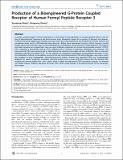Production of a Bioengineered G-Protein Coupled Receptor of Human Formyl Peptide Receptor 3
Author(s)
Wang, Xiaoqiang; Zhang, Shuguang
DownloadWang-2011-Production of a Bioe.pdf (389.8Kb)
PUBLISHER_CC
Publisher with Creative Commons License
Creative Commons Attribution
Terms of use
Metadata
Show full item recordAbstract
G-protein coupled receptors (GPCRs) participate in a wide range of vital regulations of our physiological actions. They are also of pharmaceutical importance and have become many therapeutic targets for a number of disorders and diseases. Purified GPCR-based approaches including structural study and novel biophysical and biochemical function analyses are increasingly being used in GPCR-directed drug discovery. Before these approaches become routine, however, several hurdles need to be overcome; they include overexpression, solubilization, and purification of large quantities of functional and stable receptors on a regular basis. Here we report milligram production of a human formyl peptide receptor 3 (FPR3). FPR3 comprises a functionally distinct GPCR subfamily that is involved in leukocyte chemotaxis and activation. The bioengineered FPR3 was overexpressed in stable tetracycline-inducible mammalian cell lines (HEK293S). After a systematic detergent screening, fos-choline-14 (FC-14) was selected for subsequent solubilization and purification processes. A two-step purification method, immunoaffinity using anti-rho-tag monoclonal antibody 1D4 and gel filtration, was used to purify the receptors to near homogeneity. Immunofluorescence analysis showed that expressed FPR3 was predominantly displayed on cellular membrane. Secondary structural analysis using circular dichroism showed that the purified FPR3 receptor was correctly folded with >50% α-helix, which is similar to other known GPCR secondary structures. Our method can readily produce milligram quantities of human FPR3, which would facilitate in developing human FPR as therapeutic drug targets.
Date issued
2011-08Department
Massachusetts Institute of Technology. Center for Biomedical Engineering; Massachusetts Institute of Technology. Center for Bits and AtomsJournal
PLoS ONE
Publisher
Public Library of Science
Citation
Wang, Xiaoqiang, and Shuguang Zhang. “Production of a Bioengineered G-Protein Coupled Receptor of Human Formyl Peptide Receptor 3.” Ed. Stefan Wölfl. PLoS ONE 6.8 (2011): e23076. Web. 15 Feb. 2012.
Version: Final published version
ISSN
1932-6203